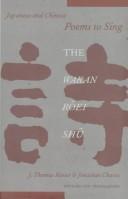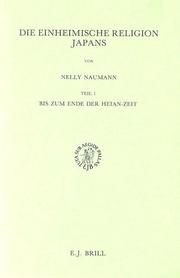| Listing 1 - 8 of 8 |
Sort by
|
Book
Year: 1965 Publisher: Tokyo : Yoshikawa Kobunkan,
Abstract | Keywords | Export | Availability | Bookmark
 Loading...
Loading...Choose an application
- Reference Manager
- EndNote
- RefWorks (Direct export to RefWorks)
Food habits --- Mythology, Japanese. --- History --- Japan --- History --- To 1185.
Book
ISBN: 0140443908 Year: 1981 Publisher: Harmondsworth : Penguin books,
Abstract | Keywords | Export | Availability | Bookmark
 Loading...
Loading...Choose an application
- Reference Manager
- EndNote
- RefWorks (Direct export to RefWorks)
J5923 --- Japan: Literature -- premodern fiction and prose -- Heian period (794-1185) --- Fiction in Japanese --- to 1185 --- Translations --- 82 --- CDL
Book
ISBN: 3700129890 9783700129899 Year: 2001 Volume: 38 687 Publisher: Wien Österreichische Akademie der Wissenschaften
Abstract | Keywords | Export | Availability | Bookmark
 Loading...
Loading...Choose an application
- Reference Manager
- EndNote
- RefWorks (Direct export to RefWorks)
Yoshida Shinto --- Shinto --- Doctrines --- History --- Histoire --- Yoshida, Kanetomo, --- Doctrines. --- History. --- Yoshida Shintō --- Yoshida Shinto - Doctrines. --- Yoshida Shinto - History. --- Shinto - History - To 1185.

ISBN: 0231107021 023110703X 9780231107020 9780231107037 Year: 1997 Publisher: New York : Columbia University Press,
Abstract | Keywords | Export | Availability | Bookmark
 Loading...
Loading...Choose an application
- Reference Manager
- EndNote
- RefWorks (Direct export to RefWorks)
This first English translation of the Wakan roei shu, includes two introductory essays, insightful commentaries on each passage, and three expositions, which discuss the collection's influence on Japanese literary history, music, and calligraphy. For centuries these short, evocative poems were memorized and cherished by Japanese courtiers who sang them at court, into lovers' ears, or at moments when spoken words failed to express their feelings. Most of the Chinese selections in this book are excerpts taken from much longer poems, with one or two verses of the original chosen to harmonize with Japanese aesthetic tastes. Now English-speaking readers can enjoy the Wakan roei shu, long treasured by Japanese readers for its revelatory beauty. The collection - arranged in accordance with the four seasons and covering more than forty topics, from celestial bodies to ministers of state - includes poems by some of the most beloved Chinese and Japanese masters, including Po Chu-i (772-846) and Sugawara no Michizane (845-903). Like haiku, the poems in the Wakan roei shu are brief and reflective, with many adhering to the classical Japanese poetic form of thirty-one syllables. Until the Meiji Restoration (1868-1912), calligraphers, poets, and artists looked to the Wakan roei shu for inspiration, incorporating its text into many of Japan's most celebrated masterpieces, from the no play Takasago to the Tale of Genji and the calligraphy of Fujiwara no Yukinari, whose eleventh-century calligraphic interpretations of the collection were treasured by Japanese for centuries.
Anthologie. --- Chinese poetry --- Chinese poetry. --- Chinesisch. --- Japanese poetry --- Japanese poetry. --- Japanisch. --- Lied. --- Lyrik. --- Poésie chinoise --- Poésie japonaise --- Tanka (poésie japonaise) --- Waka --- Waka. --- Traductions anglaises. --- To 1185.
Book
ISBN: 2913217133 9782913217133 Year: 2006 Volume: *5 Publisher: Paris : de Boccard,
Abstract | Keywords | Export | Availability | Bookmark
 Loading...
Loading...Choose an application
- Reference Manager
- EndNote
- RefWorks (Direct export to RefWorks)
Japanese imprints --- Japanese literature --- Japanese. --- Early works to 1800 --- Japan --- History --- Sources --- Littérature japonaise --- Dictionaries --- French --- Dictionnaires français --- Japon --- Civilization --- Historiography --- Civilisation --- Histoire --- Historiographie --- Japanese --- Littérature japonaise --- Dictionnaires français --- French. --- Sources. --- Japanese literature - Heian period, 794-1185 - Dictionaries --- Japanese imprints - Early works to 1800 - Bibliography - Dictionaries - Japanese --- Japan - Civilization - 794-1185 - Dictionaries --- Japan - History - To 1185 - Historiography - Dictionaries --- Japan - History - To 1185 - Source.
Book
ISBN: 9784906267637 4906267637 Year: 2010 Publisher: Tokyo The international institute for Buddhist studies
Abstract | Keywords | Export | Availability | Bookmark
 Loading...
Loading...Choose an application
- Reference Manager
- EndNote
- RefWorks (Direct export to RefWorks)
S13A/0340 --- China: Religion--Chinese Buddhism: history --- Buddhism --- Tantric Buddhism --- Tendai (Sect) --- Tiantai Buddhism --- Buddhism, Tantric --- Buddhist tantrism --- Esoteric Buddhism --- Mantrayāna Buddhism --- Mikkyō --- Tantrism, Buddhist --- Vajrayāna Buddhism --- Mahayana Buddhism --- Buddha and Buddhism --- Lamaism --- Ris-med (Lamaism) --- Religions --- Doctrines&delete& --- History --- Relations --- Relations&delete& --- Ejū, --- Saichō, --- Shunxiao, --- Eizan Daishi, --- Denkyō Daishi, --- Dengyō Daishi, --- 最澄, --- Shōjō, --- Shōjōbō Ejū, --- 惠什, --- 愉什, --- Buddhism. --- Interfaith relations. --- Tantric Buddhism. --- Tendai (Sect). --- Doctrines --- Doctrines. --- Ejū, --- Saichō, --- To 1185. --- Japan. --- Eizan, --- Denkyō, --- Dengyō,
Book
ISBN: 9789004251717 9004251715 900426454X 9789004264540 9781306405263 1306405262 Year: 2014 Volume: 45 Publisher: Leiden
Abstract | Keywords | Export | Availability | Bookmark
 Loading...
Loading...Choose an application
- Reference Manager
- EndNote
- RefWorks (Direct export to RefWorks)
In Man’yōshū and the Imperial Imagination in Early Japan , Torquil Duthie examines the literary representation of the late seventh-century Yamato court as a realm of 'all under heaven.” Through close readings of the early volumes of the poetic anthology Man’yōshū (c. eighth century) and the last volumes of the official history Nihon shoki (c. 720), Duthie shows how competing political interests and different styles of representation produced not a unified ideology, but rather a “bundle” of disparate imperial imaginaries collected around the figure of the imperial sovereign. Central to this process was the creation of a tradition of vernacular poetry in which Yamato courtiers could participate and recognize themselves as the cultured officials of the new imperial realm.
J5715 --- J5500.30 --- J3308.20 --- J5501 --- J3320 --- Japan: Literature -- poetry -- Waka, tanka, chōka -- Man'yōshū --- Japan: Literature -- history and criticism -- Heian period (794-1185) --- Japan: History -- ancient and early histories -- Nihon shoki (Nihongi) --- Japan: Literature -- policy, legislation, guidelines, codes of behavior (government, internal...) --- Japan: History -- Kodai -- Asuka and Nara period (538-794) --- Courts and courtiers in literature. --- Imperialism in literature. --- Japan -- History -- 645-794. --- Japan -- Intellectual life -- To 1185. --- Japanese literature -- To 1185 -- History and criticism. --- Japanese poetry -- To 1185 -- History and criticism. --- Man’yo ̄shu ̄ -- Criticism, Textual. --- Nihon shoki -- Criticism, Textual. --- Political culture -- Japan -- History -- To 1500. --- Politics and literature -- Japan -- History -- To 1500. --- Imperialism in literature --- Courts and courtiers in literature --- Politics and literature --- Political culture --- Japanese poetry --- Japanese literature --- Languages & Literatures --- East Asian Languages & Literatures --- History --- History and criticism --- History and criticism. --- Man'yōsh --- Nihon shoki --- Criticism, Textual. --- Japan --- Intellectual life --- Literature --- Literature and politics --- Political aspects --- Nihongi --- Yamato fumi --- Yamatobumi --- Ilbon sŏgi --- Nihon-gi --- Chronicles of Japan --- Chronicle of Japan --- 日本書紀 --- Culture --- Political science --- Rikkokushi --- Man'yōshū --- Man'yôsyû --- Man̄yefushifu --- Manʺësi︠u︡ --- Mannyōshū --- Manyŏpchip --- Wan yeh chi --- Nishi Honganji-bon Man'yōshū --- Man.yôshû

ISBN: 9004085912 9004101780 Year: 1988 Volume: 9 Publisher: Leiden Köln Brill
Abstract | Keywords | Export | Availability | Bookmark
 Loading...
Loading...Choose an application
- Reference Manager
- EndNote
- RefWorks (Direct export to RefWorks)
Japan --- Japon --- Religion --- Inscriptions --- Phaistos Disk --- Luwian language --- Inscriptions, Cypro-Minoan --- Disque de Phaistos --- Louvite (Langue) --- Inscriptions chypro-minoennes --- 299.52 --- -Inscriptions --- -Inscriptions, Cypro-Minoan --- J1700.10 --- J1700.40 --- J1970 --- Phaestus Disk --- Luian language --- Lûish language --- Luvian language --- Anatolian languages --- Extinct languages --- Cypro-Minoan inscriptions --- Cypro-Minoan script --- Inscriptions, Linear A --- Inscriptions, Linear B --- Epigraphs (Inscriptions) --- Epigraphy --- Inscription --- Paleography --- Epigraphists --- Godsdiensten van Japan. Shintoisme --- Japan: Religion in general -- history -- Kodai, prehistoric and ancient, premodern --- Japan: Religion in general -- history -- Kamakura period, Yoshino (1185-1392) and Chūsei in general (1185-1600) --- Japan: Religion -- Shintō -- history --- 299.52 Godsdiensten van Japan. Shintoisme --- J1910 --- Japan: Religion -- Shintō -- general and history --- religions [belief systems, cultures] --- Religious studies --- To 1185 --- Inscriptions, Minoan --- Minoan writing
| Listing 1 - 8 of 8 |
Sort by
|

 Search
Search Feedback
Feedback About
About Help
Help News
News